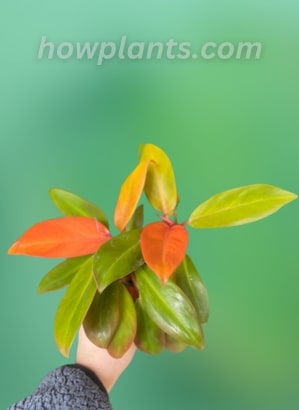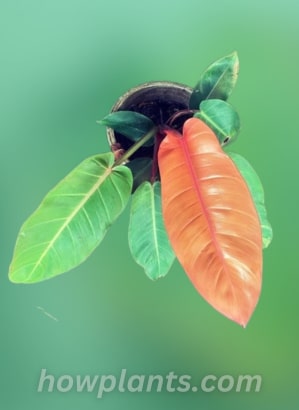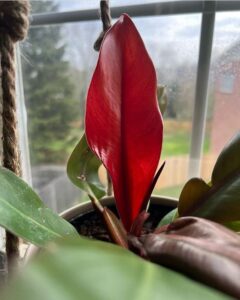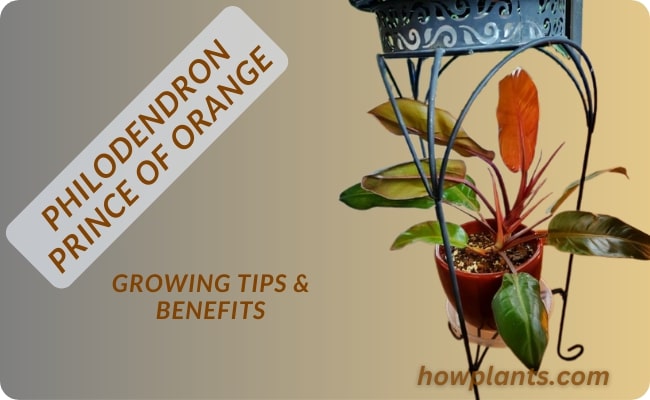Discover the beauty and benefits of the Philodendron Prince of Orange plant (Tricolor). Get all the tips you need to successfully grow and maintain this vibrant and exotic plant.
Philodendron Tricolor is a beautiful tropical plant that adds life and color to any indoor space. If you are considering bringing this plant into your home, it is essential to understand the environmental conditions that will help it thrive. Philodendron Tricolor requires bright, indirect light for optimal growth. It is best to place the plant near a window but not in direct sunlight as this can cause its leaves to burn.
What is the Prince of Orange Philodendron?
Prince of orange is a magnificent plant that has been gaining popularity in recent years. This tropical plant boasts stunning foliage that features shades of green, pink, and cream. The leaves are heart-shaped and have a glossy texture that adds to the overall beauty of the plant. Philodendron Tricolor can be grown as a houseplant or outdoors in warm climates. It is relatively easy to care for and can thrive even in low light conditions. However, it is important to keep in mind that this plant does need regular watering and should be kept at moderate humidity levels.

Origin and Family of Philodendron Tricolor
Prince of orange Philodendron, also known as Philodendron Pink Princess, is a stunning ornamental plant that has garnered much attention from horticulturists and plant enthusiasts alike. This beautiful plant originated in South America and belongs to the Araceae family. The Araceae family includes other popular indoor plants such as Peace Lily, ZZ Plant, and Monstera Deliciosa.
Philodendron Tricolor is a hybrid plant that was created by crossing two types of Philodendrons: Philodendron Erubescens and Philodendron White Knight. This crossbreeding resulted in a strikingly unique plant with variegated leaves that display an array of colors.
| CHARACTERISTICS | INFORMATION |
|---|---|
| Origin |
|
| Plant Type |
|
| Family Name |
|
| Scientific Name |
|
| Other Name |
|
| Shape of Leaves |
|
| Color of Leaves |
|
| Soil |
|
| Temperature |
|
| pH |
|
| Growth Rate |
|
| Humidity Rate |
|
| Watering Conditions |
|
| Toxicity Status |
|
| Symptoms of Toxicity |
|
| Pests |
|
Size of Philodendron Tricolor
The size of the prince of orange plant can vary depending on several factors such as its age, growing conditions, and care practices. Typically, this plant can grow up to 3-4 feet tall and spread out about 2-3 feet wide when grown in a pot. However, if it’s planted in the ground with adequate space and nutrients, it can grow much larger.
Care of Prince of Orange Plant
Owning this plant requires some level of care and attention. Firstly, Philodendron Tricolor thrives in bright but indirect light. Direct sunlight can scorch its delicate leaves, while low light conditions will cause the leaves to lose their variegation. It’s best to place it near an east or west-facing window where it can receive adequate sunlight without being exposed to the harsh midday sun.

Secondly, watering Philodendron Tricolor can be tricky because overwatering or underwatering can lead to root rot or dehydration respectively. Water only when the top inch of soil feels dry and avoid leaving it sitting in water for too long.
Environmental Conditions for Tricolor Philodendron
One of the most important factors that affect the growth and health of Philodendron Tricolor is its environmental conditions. The ideal temperature range for Philodendron Tricolor is between 65°F to 80°F. It thrives in bright indirect light, but direct sunlight can scorch its leaves. The plant requires well-draining soil that is kept moist but not waterlogged. In addition to these conditions, Philodendron Tricolor also benefits from high humidity levels which can be achieved by placing a humidifier near the plant or grouping it with other plants.
Prince of Orange Plant Price
One question that often comes up when shopping for this plant is how much does it cost? The price of Philodendron Tricolor can vary greatly depending on where you live and where you purchase it from. In general, prices can range anywhere from $20 to $100 or more. The size of the plant also plays a significant role in determining its price tag.
If you’re looking for a more affordable option, consider purchasing Philodendron Tricolor online or at your local nursery during the off-season when prices tend to be lower. Additionally, propagating your own Tricolor can be an inexpensive way to grow your collection without breaking the bank.
Growth rate of Orange Philodendron
Prince of orange plants become large rapidly, as this plant can grow quite quickly under the right conditions.
The growth rate of Philodendron Tricolor is fast, depending on several factors such as light, temperature, humidity and soil quality.
Pots for growing Philo Prince of Orange
While there are many types of pots available in the market, not all are suitable for Philodendron Tricolor. The first type of pot that is ideal for growing Philodendron Tricolor is a ceramic pot. Ceramic pots are widely used because they retain moisture well and provide excellent drainage. They also come in various colors and designs, which makes them an attractive addition to your home decor. Another great thing about ceramic pots is that they can last for years if cared for properly.
When to report your Philodendron Prince?
If you notice anything unusual about your Philodendron Tricolor plant, it’s important to report it immediately. Whether it’s discolored leaves, wilting foliage or stunted growth- these could all be signs that something isn’t right with the plant. Reporting these issues early can help prevent further damage and increase the chances of saving the plant.
Soil composition best for Philodendron Prince of Orange
The ideal soil composition for orange philodendron should be well-draining to avoid waterlogging, which can cause root rot. A mixture of peat moss, perlite or sand, and compost will provide excellent drainage while retaining enough moisture. The pH level of the soil should be between 5.5 and 7.0 for optimal growth. It’s also crucial to consider the nutrient content of the soil when choosing a mix for Philodendron Tricolor.
Ideal pH
The ideal pH range for Philodendron Tricolor is between 5.5 and 6.5. This means that the soil should be slightly acidic for optimal growth and health of the plant. If the soil pH becomes too alkaline or basic (above 7), it can lead to nutrient deficiencies and stunted growth. On the other hand, if it becomes too acidic (below 5), it can cause root damage and limit water absorption.
Water Requirements of Tricolor Plant
The Water requirements of Philodendron Tricolor are relatively simple; the plant requires moderate watering during its growing season (spring and summer) and minimal watering during its dormant period (fall and winter). The best way to determine when your Philodendron Tricolor needs water is by checking the soil’s moisture level. You can do this by sticking your finger about an inch into the soil; if it feels dry at this depth, it’s time to water your plant.
Ideal temperature for King of Orange Philodendron
The ideal temperature range for the growth of Philodendron Tricolor is between 65-75°F (18-24°C). At this temperature range, the plant can grow at an optimum rate and develop healthy foliage. However, it would help if you were careful not to expose your Philodendron Tricolor to extreme temperatures as it may impact its growth negatively. It’s important to note that Philodendron Tricolor is a tropical plant and thrives in humid conditions.
Cold tolerance of Prince Albert Plant
Philodendron Tricolor has a moderate level of cold tolerance but cannot survive prolonged exposure to freezing temperatures. This means that while it can tolerate mild winter weather, gardeners must ensure that they protect the plant from frost if they live in areas where temperatures frequently drop below freezing. Gardeners who live in particularly cold climates may want to consider bringing their Philodendron Tricolor indoors during the winter months or planting them near a south-facing wall where they can benefit from additional warmth.
Light Requirements for Prince of Orange
Firstly, it’s essential to understand that direct sunlight can harm delicate neo orange philodendron plants. The best location for your Philodendron Tricolor is near a window with filtered or indirect light exposure. North-facing windows are ideal as they have lower light intensity than south-facing ones. You can also consider using sheer curtains or blinds to filter out the harsh rays of the sun while still allowing enough light in. Secondly, keep in mind that too little light will cause your Philodendron Tricolor to grow slower and develop smaller leaves than usual.

Fertilizers for Prince of Orange
There are different types of fertilizers suitable for the Tricolor plant Philodendron. One of them is a balanced fertilizer with equal amounts of nitrogen (N), phosphorus (P), and potassium (K). This type of fertilizer will provide all the necessary nutrients needed for proper growth and development. Another suitable option is slow-release fertilizers that release nutrients gradually over time, ensuring continuous growth for your plant.
Ideal Humidity and Aeration for Philo Prince of Orange
Philodendron Tricolors prefer high levels of humidity, with around 50-60% being ideal. If the air in your home is too dry, you may need to use a humidifier or place a tray of water near the plant to increase humidity levels. In addition to humidity, proper aeration is also important for Philodendron Tricolors. These plants thrive in well-draining soil that allows air circulation around their roots. This means that it’s essential to have good drainage holes in your pot and avoid over watering the plant as this can lead to root rot and poor aeration.
How to propagate the Philodendron Orange?
If you are looking to grow a prince orange philodendron plant in your garden, propagating it from cuttings is the best way to do so. In this article, we will discuss how you can propagate Philodendron Tricolor easily.
Steps of Propagating Philo Neon Orange through stem cutting in Soil
- The first step in propagating Philodendron Tricolor through stem cutting in soil is to select a healthy mother plant.
- Look for a mature plant that has at least three leaves and several nodes on its stem. Nodes are the small bumps that develop where leaves meet stems, and they are essential for root formation during propagation.
- Once you have selected your mother plant, use sterilized pruning shears or scissors to cut off about 6 inches of stem, making sure there are at least two nodes on the cutting.
- Plant this cutting, in a pot filled with soil until it develops roots and grows into a new plant.
When Philodendron Tricolor’s grow? Flowers Size, Shape, Color
The philodendron neon oranges are small and inconspicuous, but they can still be an attractive feature for those who appreciate the intricacies of nature.
The flowers of Philodendron Tricolor typically grow in clusters on tall stalks that emerge from the center of the plant. They are usually white or cream-colored and tend to be quite small, measuring only about 1-2 centimeters in length. While these flowers may not be as showy as other flowering plants, they have a delicate beauty all their own and can make a lovely addition to any indoor garden.

Toxicity Status of Tricolor Orange
Queen of orange Philodendron has its toxicity status that every pet owner and parent should know. According to the American Society for the Prevention of Cruelty to Animals (ASPCA), congo orange plant contains calcium oxalate crystals that can cause oral irritation when ingested. Symptoms may include drooling, difficulty swallowing, vomiting, and diarrhea. In severe cases, it can lead to swelling of the mouth or throat which could potentially be life-threatening. While Philodendron Tricolor is harmful when ingested by pets or humans, it does not pose a threat if touched or smelled.
Pest that can attack Prince Plant
There are several pests that commonly attack this species of variegated prince of orange, and they can cause extensive damage if left untreated.
One pest that often attacks Philodendron Tricolor is spider mites. These tiny arachnids are usually found on the undersides of the leaves and form webs around the plant. They suck sap from the leaves causing them to turn yellow or brown and eventually dry up. Another common pest is mealybugs which attach themselves to the stems and leaves of the plant, sucking out sap and causing stunted growth. The infested areas may appear white or cottony in appearance.
Fungus Gnats
Fungus giants are small, dark flies that tend to gather on plants and in soil. They are generally harmless to humans but can cause significant damage to plants like Philodendron Tricolor. These tiny pests lay their eggs in the soil of potted plants, where they hatch into larvae that feed on organic matter and plant roots.
As the larvae grow, they become known as fungus giants due to their size relative to other gnats. Fungus giants can cause severe damage to a plant’s roots and leave it susceptible to disease or nutrient deficiencies. If left unchecked, an infestation of fungus gnats can quickly spread throughout a home or garden, causing significant harm to your beloved Philodendron Tricolor.
Powdery Mildew
Powdery mildew is a fungal disease that affects plants, causing white or grayish spots to appear on the leaves and stems. It can also lead to stunted growth and eventually kill the plant if left untreated. Philodendron Tricolor is one of the plants that are susceptible to powdery mildew infestations.
Another pest that commonly attacks Philodendron Tricolor is whiteflies. They are tiny insects that feed on plant sap, causing damage to the leaves and reducing photosynthesis. The presence of whiteflies can also attract other pests like ants and cause mold growth due to their sugary excretions. To get rid of powdery mildew, it’s important to identify the infected area and remove it immediately.
Scale Insects
Scale insects are tiny, oval-shaped pests that attach themselves to the stems and leaves of plants, including the princess of orange plant. They are covered with a waxy shell that protects them from predators and insecticides. These pests feed on sap from the plant, which can lead to stunted growth and yellowing or wilting leaves. If left untreated, an infestation of scale insects can ultimately kill the plant.
The Philodendron Tricolor is particularly vulnerable to these pests due to its delicate foliage and soft stems. Scale insects often attack this plant by feeding on the undersides of leaves and hiding in crevices along stems. Early detection is crucial when it comes to controlling an infestation of scale insects on your Philodendron Tricolor. Spry your plant by diluted neem oil or insecticidal soap to get rid of these insects.
Mealy Bugs
Mealybugs are tiny insects that can cause significant damage to the prince albert Philo. These pests are characterized by their white, cotton-like appearance and can be found on the leaves, stems, and even roots of your plant. They feed on the sap of your plant by piercing through the tissue with their sharp mouthparts. This feeding causes yellowing and wilting of leaves leading to stunted growth.
If left untreated, mealybugs can spread quickly throughout your Philodendron Tricolor plant resulting in severe damage or death. The bugs also secrete a sticky substance called honeydew which attracts ants and other pests that further harm your plant by spreading diseases.
Against mealybugs use a mixture of rubbing alcohol, water and dish wash (fragrance free)
Root rot
Root rot is caused by overwatering, poor drainage or fungal infections that cause the roots to decay and turn brown or black.
If left untreated, root rot can be extremely harmful to Philodendron Tricolor and ultimately lead to the death of the plant. Some signs of root rot include wilting leaves, yellowing foliage, stunted growth or an unpleasant odor emanating from the soil. The best way to prevent root rot is by regularly checking the soil for moisture levels, ensuring proper drainage and avoiding over-fertilizing.
Other problems related to Plant Prince of Orange
Drooping Leaves
However, despite being relatively low-maintenance, these plants can sometimes suffer from drooping leaves. One common reason for drooping leaves in Philodendron Tricolor is overwatering or underwatering. These plants prefer moist but well-drained soil; if the soil is too wet or too dry, it can cause stress on the roots and lead to droopy foliage. Another possible cause is lack of humidity; these tropical plants thrive in humid environments but may struggle in dry conditions.
Yellowing Leaves
One of the most common problems that Philodendron Tricolor owners face is the yellowing of its leaves. This can be a sign of various issues, such as overwatering or underwatering, low light levels, pests or diseases.
One of the main reasons why Philodendron Tricolor leaves turn yellow is due to overwatering. When there is too much water in the soil, it deprives the roots of oxygen which leads to root rot and eventually causes leaf yellowing. To prevent this problem from happening, it’s essential to ensure proper drainage and avoid leaving standing water in the pot for prolonged periods. Another reason for leaf yellowing can be insufficient light levels.
Brown Tips
One of the main reasons why the tips of Philodendron Tricolor leaves turn brown is due to overwatering. This plant needs well-draining soil and doesn’t like to sit in water. When roots are consistently wet or submerged in water, they begin to rot and damage spreads up into the leaves. To avoid this issue, ensure your pot has drainage holes at the bottom and allow excess water to drain away completely after watering.
Philodendron McColley’s Finale Vs Philodendron Prince Of Orange
Philodendron McColley’s Finale and Prince of Orange are two popular varieties of the Philodendron plant. While they may look similar, there are some key differences that set them apart. Let’s take a closer look at these plants and see which one comes out on top.
Philodendron McColley’s Finale is known for its compact size and deep green leaves with a glossy finish. It’s a low-maintenance plant that can thrive in both bright and low light conditions, making it ideal for any indoor space. On the other hand, Prince of Orange has striking orange-colored new growth that eventually turns to dark green as it matures. This variety also prefers bright to medium indirect light but requires more frequent watering than McColley’s Finale.

Is Philodendron Prince Of Orange Rare?
Philodendron Prince of Orange is a unique and beautiful plant that has become quite popular among houseplant enthusiasts. With its vibrant orange leaves and attractive heart-shaped foliage, it’s no wonder why many people are asking whether it’s a rare species or not. However, the answer to this question is not as straightforward as one may think.
While Philodendron Prince of Orange is not considered an extremely rare plant, it can still be difficult to find at times. This is because it’s a relatively new hybrid cultivar that was created by crossing two different Philodendron species. As such, it’s only been available on the market for a few years now, which means that there hasn’t been enough time for large-scale production and distribution.
That being said, the availability of the Philodendron Prince of Orange largely depends on where you live and where you shop for plants.
Conclusion
In conclusion,Philodendron Tricolor is a magnificent and unusual species of plants that can bring beauty and joy to any home. In conclusion,Philodendron Tricolor is a popular houseplant that grows in tropical regions. They are easy to care for and maintain, with minimal need for pruning or repotting. They thrive in bright indirect sunlight and moist soil, and can be propagated by stem cuttings, division, or air layering. With proper care and attention, these plants will reward you with vibrant foliage that adds texture and color to any room.
